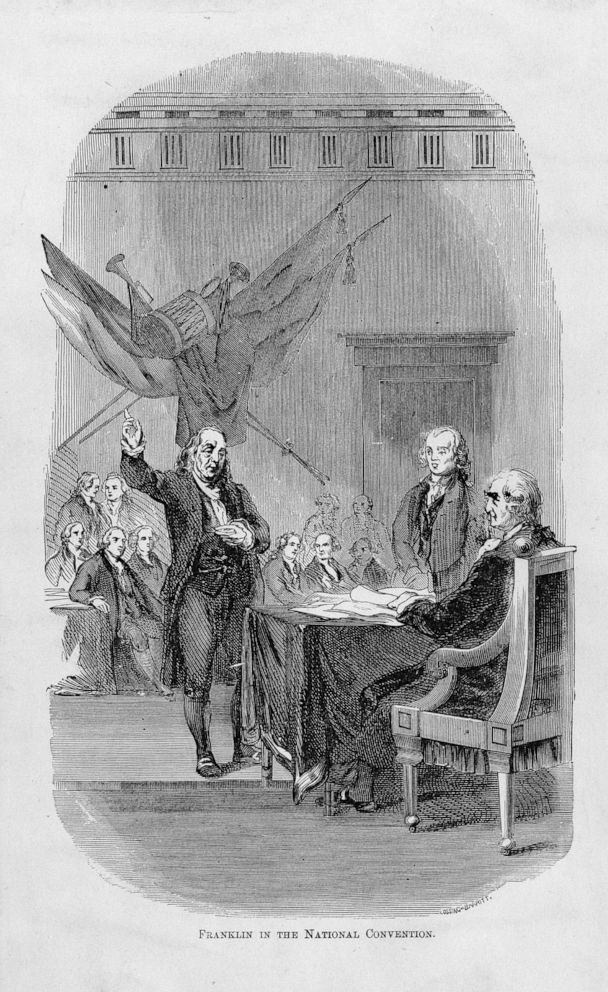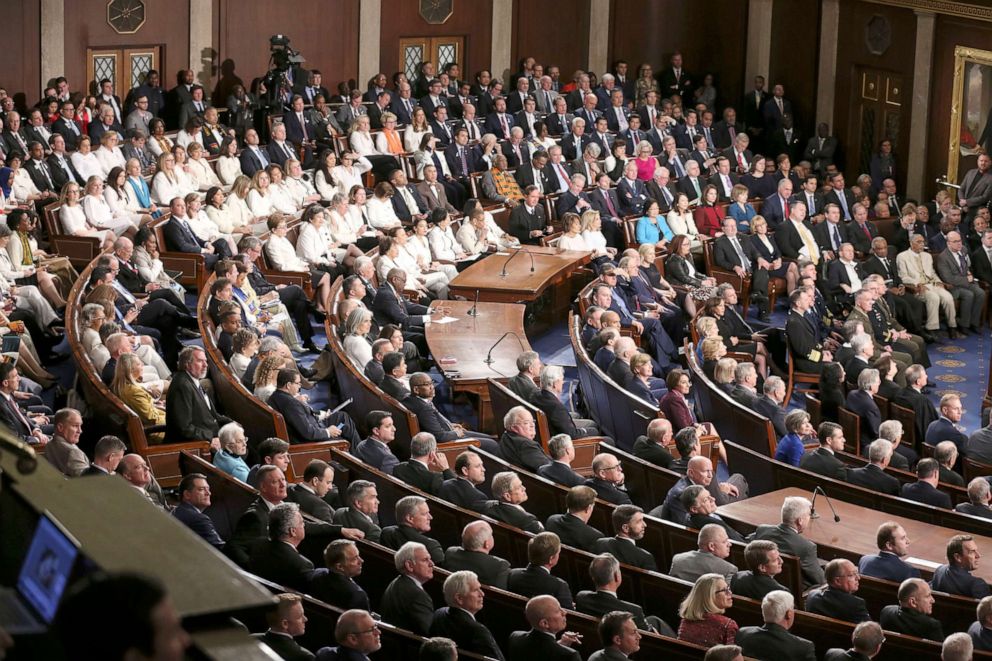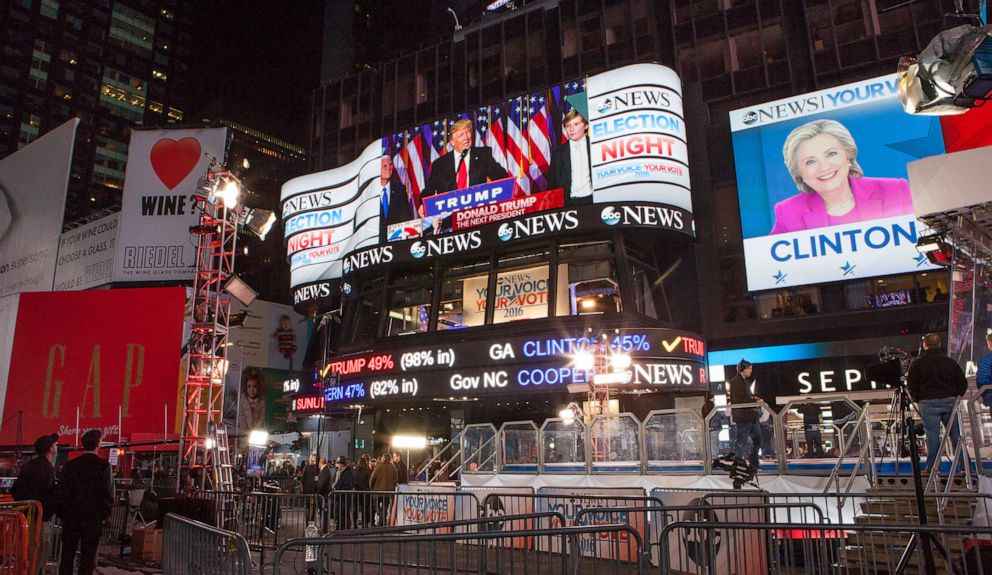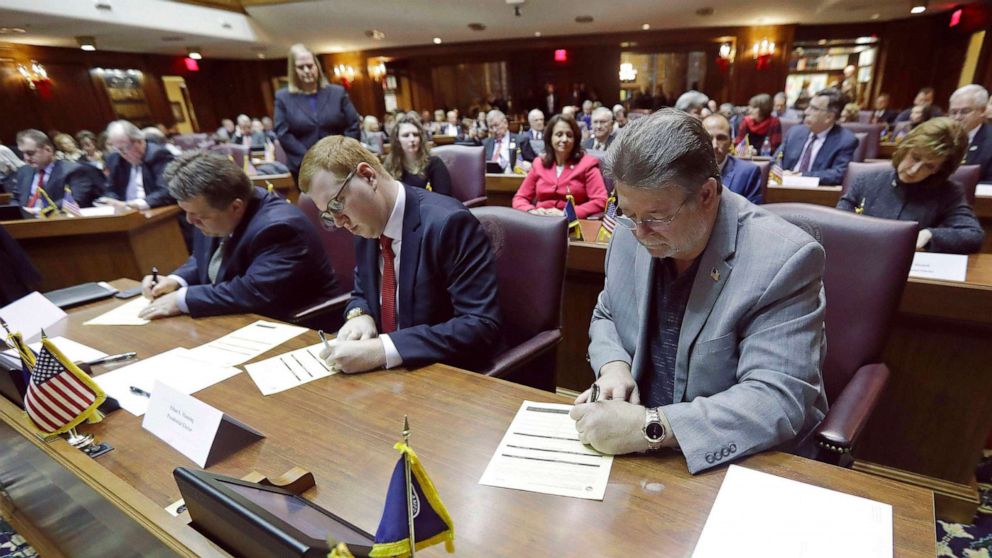11月3日,普选将直接决定投票上下的获胜者,除了一个。
虽然选民选举国会议员、州长官邸的居住者、州议员、市长和其他地方官员,但国家的最高职位是由选举团——宪法确立的美国选举制度的一个模糊而有争议的特征。
在每一届总统选举中选举,可以追溯到这个国家的第一次是在1789年,选民为一批选民投票,这些选民通常是由一个州的政党提名的党派忠诚者,承诺支持被提名者。
两位总统候选人争夺所需的538张选举人票中的270张来入主白宫。由于一些州坚定地站在共和党或民主党的一边,选举地图上的焦点通常会缩小到关键战场——一群可能会使选举偏向一名候选人的州。
以下是关于选举团的一些信息:
为什么是选举团?
1787年,费城制宪会议代表之间的主要冲突是选举总统的过程。由于在授权国会或拥有选举首席执行官能力的受欢迎的多数派之间的计划存在争议,开国元勋们最终选择了选举团作为妥协。
自成立以来,选举团一直是该国投票过程中的一个怪癖——一群选民根据国会代表反映了各州的权力分配。

国会图书馆/印刷与摄影部
在这幅版画中,本杰明·富兰克林被描绘成在费城举行的1787年全国代表大会上讲话。
纽约大学宪法学教授、选举法专家理查德·皮尔德斯(Richard Pildes)表示,这一制度旨在平衡南北之间的部门利益——这一分歧“映射”了奴隶制问题——并通过不赋予国会对总统职位过大的影响力来保护权力分立。
耶鲁大学法律和政治学教授阿基尔·阿玛(Akhil Amar)在他的著作《今日宪法:我们时代问题的永恒教训》中写道:“南方人不会支持总统的直接普选,因为奴隶州不会因为他们的人类财产而获得任何荣誉。”
间接的总统之路也使总统的选择免受“派系”的痛苦,詹姆斯·麦迪逊在《联邦党人报》上警告说,作为一个他认为“由某种共同的激情或利益冲动所团结和驱动,与其他公民的权利或社区的永久和总体利益相抵触”的团体。皮尔德斯说,由于缺乏对潜在候选人的“全国熟悉度”,这一机制打消了创始人对18世纪选民不太了解候选人的担忧。
制宪者认为,这一制度是国会选举总统和民众投票选举总统之间的中间地带,将是一个四年一次的选举机构,只在各自的州举行会议,这使得“腐败过程更加困难,”皮尔德斯说有些人担心外来干涉。
选民是谁?
每四年,两个政党在选举前的几个月选择他们的选民在一次会议上投票设置为根据联邦法律,今年12月14日是“总统选举年12月第二个星期三之后的星期一”。
选举人在他们各自的州和首都集会,在州立法机关确定的地方分别为总统和副总统投票。获得多数票的候选人被正式选入白宫。
选择选民的过程因州而异,一些州在党代会上提名选民,而另一些州则由选民在初选过程中选举他们。
“我们没有全国统一的选举人任命制度,这意味着立法机构根本不需要征求公众的意见。”书写弗吉尼亚大学政治学教授詹姆斯·W·凯瑟和医学博士杰米·拉斯金代表国家宪法中心。
选民通常是每个政党中的重要人物,他们具有象征意义。2016年,前总统比尔·克林顿是选民来自纽约。今年,佐治亚州众议院前少数党领袖史黛西·艾布拉姆斯(Stacey Abrams)将成为该州民主党的选民,唐纳德·特朗普(Donald Trump)总统2016年竞选经理科里·莱万多夫斯基(Corey Lewandowski)是新罕布什尔州共和党的选民。
选举团是如何运作的?
总统由538名选民组成的团体选举产生,需要270张选票才能获胜。
分配给各州的选民人数是基于人口的——反映了每个州的国会代表性,每个美国参议员和众议员有一张选举人票。每个州和哥伦比亚特区至少有三名选民。
在48个州,加上该国的首都,选举人的选票是用赢家通吃的制度授予的,但是缅因州和内布拉斯加州不同,允许选举人的选票被分开。这两个州给每个国会选区的获胜者一张选举票——缅因州有两张,内布拉斯加州有三张——剩下的两张选举票分配给全州的获胜者。
皮尔德斯说,选民大多是“他们所在州民众投票的渠道”,12月的会议在很大程度上是一种形式。
有些人可能会违背自己的承诺,去投票给他们政党的候选人,就像2016年的七个人那样,但这种情况“在我们的历史上发生过非常非常少的几次,”他继续说道。
最高法院在7月份对“无信仰选民”一案做出了裁决,使宪法允许约束选民投票给普选获胜者。
三十三个州和华盛顿特区,要求选举人遵守他们的誓言。至少有五个州存在对违抗投票的惩罚,而十几个州取消并替换了流氓选民。皮尔德斯补充说,未来几年可能会颁布更多法律,要求选民跟随普选。
如果打成平手会怎么样?
该体系并非没有缺陷,尤其是在最初几年。
在1804年之前,第二名成为副总统。1800年选举后出现了一个关键的变化,当时约翰·亚当斯与托马斯·杰斐逊竞选。投票结果显示杰弗逊和他的副总统竞选伙伴艾伦·伯尔打成平手,剩下的选举要由众议院来打破平手。
一场激烈的政治运动随之而来,众议院议员权衡两个邪恶中较小的一个:许多联邦党人视杰斐逊为“主要敌人”,根据国家档案馆而伯尔被视为野心勃勃。在亚历山大·汉密尔顿的领导下,众议院在第36次投票中授予杰斐逊最高职位,伯尔成为他的第二号人物。

美国国家情报保护局通过美联社,文件
2019年2月5日,在华盛顿美国众议院两院的一次联席会议上,民主党人和共和党议员在听特朗普总统的国情咨文。
在这场混乱的比赛之后第十二修正案1804年被批准,总统和副总统的投票被分开以避免类似的结果。
“自动将总统最大、或许也是最激烈的政治对手置于第二位,这是不稳定的,离高层只有一步之遥,”阿玛在他的书中写道。“然而,这一变化的效果是重新定义了美国最高两名官员之间的关系——平息了曾经在该体系中建立的敌意。”
纵观这个国家的历史,只有三次类似于1800年的“临时选举”。
如果没有候选人获得多数选举人票,或者在票数相等的情况下,每个候选人获得269张选举人票,则选举转移到众议院根据第12修正案选出下一任总统。众议院只从得票最多的三个人中投票。
每个州在众议院都有一票——这使得该党在更多的代表团中拥有更大的代表性。根据联邦法律,这一过程在美国历史上只发生过两次,将于2021年1月初,在就职典礼之前结束。
共和党目前控制着26个代表团,而民主党控制着22个,宾夕法尼亚州在两党中平分秋色。但将于11月选出的新国会决定了至关重要的投票。
民主党以一个席位控制了亚利桑那州、爱荷华州、明尼苏达州和内华达州等几个竞争激烈的总统竞选州的代表团,而共和党在佛罗里达州拥有一个席位的优势。
总统候选人需要26张多数票才能获胜。
任何有争议的副总统的决定都在参议院解决,1837年的第三次临时选举就是这种情况,每个参议员投一票。在上议院,候选人必须赢得51票才能成功。
如果众议院在就职典礼上陷入僵局,当选副总统将担任代理总统,直到众议院选出新的总司令。
总统会输掉普选但仍能赢得选举吗?
四年前,特朗普以304票对227票成为选举团的获胜者,尽管他以近300万票的优势输给了希拉里·克林顿(Hillary Clinton)——这一结果只发生在五次总统选举中:1824年、1876年、1888年、2000年和2016年。
2016年,特朗普最微弱的胜利是在密歇根州——略低于11000票——但他赢得了该州所有16张选票,最终赢得了白宫。
在2000年有争议的选举中,最高法院对佛罗里达州的投票作出了臭名昭著的决定,乔治·布什以271票对266票赢得了选举团,击败了阿尔·戈尔,后者以50多万票赢得了普选。

通过盖蒂图像的图片联盟
时代广场的屏幕上显示了2016年11月9日在纽约宣布唐纳德·特朗普当选总统的选举结果。
在大多数州都有赢家通吃的机制的情况下,选举团的结果和全国大多数选民的意愿有时会出现分歧,这助长了更换整个系统的呼声。
选举团会长久吗?
根据国家档案馆的数据,在过去的200年里,国会已经提出了700多项改革或取消选举团的提案,但都没有成功。
离解散选举团最近的一次国会会议发生在20世纪60年代末至70年代初,当时众议院果断通过了一项废除选举团制度的修正案唯一的一次国会会议批准了这样一项修正案。但是在被一群来自南方各州的立法者阻挠后,它在参议院夭折了。
去年,在最终让前副总统乔·拜登获胜的竞争性民主党初选中,一些更进步的竞选者将取消选举团作为他们竞选纲领的一部分。
“我的观点是,每一票都很重要。我们实现这一目标的方法是,我们可以进行全国投票,这意味着取消选举团,”马萨诸塞州参议员伊丽莎白·沃伦说。,2019年3月说。
与沃伦类似,一些人认为选举团是“一个应该改变的不同时代的产物”,巴尔的摩大学教授金伯利·韦勒说,说上个月。
超过五分之三的美国人(61%)支持用普选制取代选举团,盖洛普民意测验发现于九月,但是沿着党派界线有明显的裂缝。民主党人支持由普选决定的选举的可能性是共和党人的近四倍。

达隆·卡明斯/美联社档案
2016年12月19日,印第安纳州选举团的印第安纳州代表在印第安纳波利斯的州议会签署文件,正式为当选总统唐纳德·特朗普投票。
皮尔德斯说,在2016年选举之前的几十年里,大多数人认为选举团倾向于支持民主党,但在上次总统竞选之后,这一制度现在被认为对共和党有利。
皮尔德斯说:“这部分是因为民主党人应该有这些州的‘蓝墙’,他们将在中西部的每一次选举中获胜。”。“正如我们在2016年看到的那样,一旦那堵蓝色的墙被打破,景色就会改变。”
彻底取消选举团将是一项艰巨的任务,因为它与宪法密不可分,需要宪法修正案,这需要国会两院三分之二的批准或三分之二的州立法机构召集的宪法会议,然后由四分之三的州批准。
另一条路线是改变现有框架,而不改变宪法。
至少有两条改革之路,包括各州修改各自分配选民的法律(例如,转向按比例分配),或者各州签署全国民众投票州际契约。
后者是一项以州为基础的努力,旨在获得足够的管辖权来制定一项法案,向在全国赢得普选的人承诺选举人票。拥有196张选票的至少16个州加入了该协议。在各州获得270张选举人票之前,该法案不会生效。
“选举团现在有点不符合当代关于民主应该意味着什么的观点。我认为我们是唯一一个以这种间接方式选举行政长官的主要民主国家。
The Electoral College: How presidents are elected
On Nov. 3, the popular vote will directly decide the winners of races up and down the ballot,except for one.
While voters elect members of Congress, occupants of governor's mansions, state legislators, mayors and other local officers, the nation's highest office is determined by theElectoral College-- an obscure and controversial feature of America's electoral system established by the Constitution.
In every presidentialelection, dating back tothe country's first in 1789, voters cast their ballots for a slate of electors, who are often party loyalists nominated by a state's political party to pledge support to the nominee.
The two presidential candidates jockey for the needed 270 electoral votes of the 538 total at stake to clinch the White House. With some states solidly in Republicans' or Democrats' corner, the focus on the electoral map typically narrows to the key battlegrounds -- a collection of states that are likely to tilt the election in one candidate's favor.
Here's what to know about the Electoral College:
Why the Electoral College?
In 1787, the primary conflict between delegates at the Constitutional Convention in Philadelphia was over the process for electing the president. With dueling plans over either empowering Congress or a popular majority with the ability to elect the chief executive, the Founding Fathers ultimately settled on the Electoral College as a compromise.
Since inception, the Electoral College has been a quirk in the country's voting process -- a group of electors who reflect the distribution of power across the states, based on congressional representation.
In this engraving, Benjamin Franklin is depicted speaking at the 1787 National Convention held in Philadelphia.
The system was designed to both balance sectional interests between the north and south -- a divide that "mapped" the slavery issue -- and to shield the separation of powers by not giving Congress outsize influence over the presidency, said Richard Pildes, a professor of constitutional law at New York University and an expert on election law.
"Southerners wouldn't stand for direct popular election of the president because slave states would get no credit for their human chattel," wrote Akhil Amar, a professor of law and political science at Yale University, in his book, "The Constitution Today: Timeless Lessons for the Issues of Our Era."
The indirect pathway to the presidency also insulated the choice for the president from the throes of "factions," which James Madison warned against in the "Federalist Papers" as a group he viewed as "united and actuated by some common impulse of passion, or of interest, adversed to the rights of other citizens, or to the permanent and aggregate interests of the community." And in the absence of "national familiarity" with potential picks, the mechanism thwarted concerns among the founders over 18th Century voters not knowing much about the candidates, Pildes said.
The system, the framers decided, was a middle ground between electing the president by Congress and by a popular vote, and would be a quadrennial institution of electors that only met in their individual states, making "it harder to corrupt the process," Pildes said, assome fearedforeign interference.
Who are the electors?
Every four years, both political parties choose their electors in the months before the election to cast votes at a meetingset forthe "Monday after the second Wednesday in December of presidential election years," which falls on Dec. 14 this year, according to federal law.
The electors meet in each of their respective states and the nation's capital to cast separate ballots for president and vice president at places determined by the state legislature. The candidates who receive a majority of the vote are formally elected to the White House.
The process for choosing the electors varies by state, with some nominating their electors at party conventions, while others leave it to voters to elect them during the primary process.
"We have no uniform national system for appointing Electors, which means the legislatures do not have to consult the public at all,"wroteJames W. Ceaser, a professor of politics at the University of Virginia, and Rep. Jamie Raskin, D-Md., for the National Constitution Center.
The electors, who are often prominent figures in each party, are of symbolic import. In 2016, former President Bill Clintonwas an electorfrom New York. This year, Stacey Abrams, the former minority leader in the Georgia State House, will be an elector for the Democratic Party in that state, and Corey Lewandowski, President Donald Trump's 2016 campaign manager, is an elector for the Republican Party in New Hampshire.
How does the Electoral College work?
The president is elected by a college of 538 electors and it takes 270 votes to win.
The number of electors apportioned to states is based on population -- mirroring each state's congressional representation with one electoral vote for each U.S. senator and representative. There is a minimum of three electors per state and the District of Columbia.
In 48 states, plus the nation's capital, electoral votes are awarded using a winner-take-all system, but Maine and Nebraska are different, allowing electoral votes to be split. These two states award one electoral vote to the winner in each congressional district -- with Maine having two and Nebraska having three -- and the remaining two electoral votes are allotted to the statewide winner.
The electors are mostly "conduits for the popular vote in their state," with the December meeting largely being a formality, Pildes said.
Some can break their pledge to vote for their party's nominee, as seven did in 2016, but this has "happened very, very few times in our history," he continued.
The Supreme Court ruled on the "faithless electors" case in July, making it constitutionally permissible to bind electors to vote for the popular vote winner.
Thirty-three states, and D.C.,require electorsto keep their pledge. In at least five states, penalties exist for defiant votes, while over a dozen states cancel and replace the rogue elector. More laws are likely to be enacted over the coming years to require electors to follow the popular vote, Pildes added.
What happens if there is a tie?
The system has not been without its kinks, particularly in its earliest years.
Before 1804, the second-place finisher became the vice president. A key change emerged after the election of 1800, when John Adams ran against Thomas Jefferson. The vote tally produced a tie between Jefferson and his vice presidential running mate, Aaron Burr, leaving the election up to the House of Representatives to break the tie.
A fierce political campaign ensued with members of the House weighing the lesser of two evils: many Federalists viewed Jefferson as a "principal foe," according to theNational Archives, while Burr was seen as nothing more than ambitious. Led by Alexander Hamilton, the House awarded Jefferson the highest office in the land on the 36th ballot and Burr became his No. 2.
Democrats and Republicans lawmakers listen during President Trump's State of the Union address to a joint session of Congress in the chamber of the U.S. House of Representatives in Washington, Feb. 5, 2019.
In the aftermath of the messy contest, the12th Amendmentwas ratified in 1804 and separated the votes for president and vice president to avoid a similar outcome.
"It was destabilizing to automatically place the president's biggest and perhaps fiercest political rival in the position of number two, a heartbeat away from the top," Amar wrote in his book. "The effect of the change, however, to redefine the relationship between American's top two officers -- quelling the animosity once built into the system."
Throughout the country's history, there have been only three "contingent elections" similar to the 1800 race.
If no candidate receives a majority of electoral votes, or in the case of a tie, in which each candidate gets 269 electoral votes, theelection moves to the Houseto select the next president under the 12th Amendment. The House only votes from among the top three vote getters.
Each state has a single vote in the House -- giving the party with greater representation in more delegations the upper hand. Under federal law, the process, which has only taken place twice in U.S. history, would play out in early January 2021, ahead of the inauguration.
Republicans currently control 26 delegations, while Democrats hold 22, with one state, Pennsylvania, being evenly split between both parties. But it's the new Congress, which will be elected in November, that determines the all-important vote.
Democrats control the delegations of several competitive presidential battleground states -- such as Arizona, Iowa, Minnesota and Nevada -- by a single seat, while Republicans have a single-seat advantage in Florida.
A presidential candidate needs a majority -- 26 votes -- to win.
The decision for any contested vice president is settled in the Senate, which was the case in the third contingent election in 1837, with each senator casting a single vote. In the upper chamber, a candidate must earn 51 votes to succeed.
If the House remains deadlocked by the inauguration, the vice president-elect will serve as acting president until the House picks a new commander-in-chief.
Can a president lose the popular vote but still win the election?
Four years ago, Trump emerged as the winner of the Electoral College, 304-227, despite losing the popular vote by nearly 3 million votes to Hillary Clinton -- an outcome that has only occurred in five presidential elections: 1824, 1876, 1888, 2000 and 2016.
In 2016, Trump's thinnest margin of victory was in Michigan -- just under 11,000 votes -- yet he won all 16 of the state's electoral votes, and ultimately, the White House.
In the contested election of 2000, which involved an infamous Supreme Court decision over Florida's votes, George W. Bush prevailed by winning the Electoral College, 271-266, over Al Gore, who won the popular vote by more than 500,000 votes.
Screens in Times Square show election results declaring Donald Trump to be President-elect on Nov. 9 2016, in New York.
With a winner-take-all apparatus in most states, the results of the Electoral College and the will of the plurality of voters across the country have at times diverged -- fueling calls for the entire system to be replaced.
Will the Electoral College last?
Over the last 200 years, more than 700 proposals have been introduced in Congress to reform or eliminate the Electoral College, according to the National Archives, without any succeeding.
The closest Congress came to dismantling the Electoral College occurred in the late 1960s-early 1970s, when the House decisively passed an amendment to abolish the system -- theonly time a chamber of Congressapproved such an amendment. But it died in the Senate after being filibustered by a group of lawmakers from southern states.
Last year, throughout the competitive Democratic primary that ultimately crowned former Vice President Joe Biden the winner, some of the more progressive contenders made scrapping the Electoral College a plank of their campaign platform.
"My view is that every vote matters. And the way we can make that happen is that we can have national voting and that means get rid of the Electoral College," Sen. Elizabeth Warren, D-Mass., said in March 2019.
Similar to Warren, some view the Electoral College as "an artifact of a different time that should change," Kimberly Wehle, a professor at the University of Baltimore,saidlast month.
More than three-fifths of the country, 61%, support replacing the Electoral College with a popular vote system,a Gallup pollfound in September, but there are fissures starkly along partisan lines. Democrats are nearly four times as likely as Republicans to back shifting to an election decided by a popular vote.
Indiana representatives to the Electoral College sign paperwork to officially cast votes for President-elect Donald Trump at the Statehouse in Indianapolis, Dec. 19, 2016.
For a few decades before the 2016 election, most viewed the Electoral College as tending to favor Democrats, Pildes said, but in the aftermath of the last presidential contest, the system is now seen as advantaging Republicans.
"That was partly because the Democrats supposedly had this 'blue wall' of these states that they were just going to win in every election that ran through the Midwest," Pildes said. "As we saw in 2016, once that blue wall could be broken, the view has moved."
Eliminating the Electoral College entirely would be an arduous endeavor since it is hard-wired into the Constitution and would require a constitutional amendment, which involves approval from either two-thirds of both chambers of Congress or a constitutional convention called by two-thirds of state legislatures, followed by ratification by three-fourths of the states.
The other route would be altering the existing framework, without changing the Constitution.
At least two pathways for reform include states modifying their individual laws for allocating electors -- for example, moving to a proportional basis -- or states signing onto thenational popular vote interstate compact.
The latter is a state-based effort that seeks to get enough jurisdictions to enact a bill that pledges electoral votes to whomever wins the popular vote nationally. At least 16 states, home to 196 electoral votes, have joined the compact. The bill won't take effect until the states reach 270 electoral votes.
"The Electoral College is now kind of out of keeping with contemporary views about what democracy should mean. I think we're the only major democracy that elects its chief executive in this indirect way," Pildes said.






